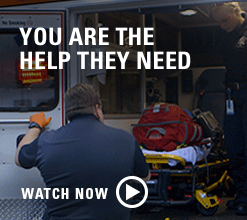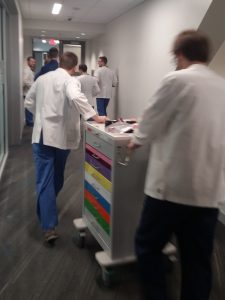Archive for the ‘Mass shooting’ Category
“Today’s search warrant might have prevented a deadly, violent incident, like the one we recently saw in Orlando.”
Monday, June 20th, 2016MCI: Shootings (1999-2015)
Thursday, June 16th, 2016Stop the Bleeding Coalition Partners
Washington, D.C. 20003


- Sauaia, A; Moore, FA Moore EE, et al (1995). “Epidemiology of trauma deaths”. Journal of Trauma 38: 185–193.
- Jump up^ Carey, ME (1996). “Analysis of wounds incurred by U.S. Army Seventh Corps personnel treated to Corps hospitals during Operation Desert Storm”. Journal of Trauma: 165–169.
- http://usatoday30.usatoday.com/news/nation/ems-day2-cover.htm
- http://leb.fbi.gov/2014/january/active-shooter-events-from-2000-to-2012
- http://www.globalresearch.ca/mass-shootings-in-america-a-historical-review/5355990
- http://www.cnn.com/2013/09/16/us/20-deadliest-mass-shootings-in-u-s-history-fast-facts/
The “Stop the Bleed” Program
Tuesday, June 14th, 2016https://www.youtube.com/watch?v=IbQF_dqRH6w
Stop the Bleed

No matter how rapid the arrival of professional emergency responders, bystanders will always be first on the scene. A person who is bleeding can die from blood loss within five minutes, therefore it is important to quickly stop the blood loss.
“Stop the Bleed” is a nationwide campaign to empower individuals to act quickly and save lives.
Remember to be aware of your surroundings and move yourself and the injured person to safety, if necessary.
Call 911.
Bystanders can take simple steps to keep the injured person alive until appropriate medical care is available. Here are three actions you can take to help save a life:
Compress
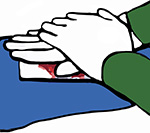
Find where the bleeding is coming from and apply firm, steady pressure to the bleeding site with bandages or clothing
Tourniquet
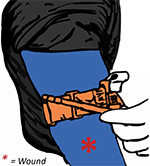
If the bleeding doesn’t stop, place a tourniquet 2-3 inches closer to the torso from the bleeding. (The tourniquet may be applied and secured over clothing.)
Pull the strap through the buckle, twist the rod tightly, clip and secure the rod with the clasp or the Velcro strap.
Compress Again
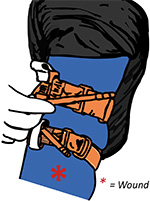
If the bleeding still doesn’t stop, place a second tourniquet closer to the torso from the first tourniquet.
Pull the strap through the buckle, twist the rod tightly, clip and secure the rod with the clasp or the Velcro strap.
* One type of tourniquet is depicted in the illustrations.
More Information
You can learn more about how to “Stop the Bleed” and help save a life by accessing these training and resources:
- Download the steps above as a shareable infographic (229 KB JPG)
- Download a high resolution copy of the “Stop the Bleed” logo (152 KB JPG)
- NAEMT Bleeding Control for the Injured
- Army Combat Casualty Care Research Program
To learn more or to get involved in the Stop the Bleed Campaign, contact us at stopthebleed@hq.dhs.gov.
Orlando Regional Medical Center admitted 44 patients after the mass shooting at the Pulse nightclub, and an additional 9 people were declared dead shortly after arriving at the hospital
Monday, June 13th, 2016“Many of the gun shot wounds were fairly severe…..Many trunk, abdomen and extreme gun shot wounds. Our operating room has been quite busy all day long with those injuries. ”
The Worst Mass Shooting in American History: 50 dead so far
Sunday, June 12th, 2016Orlando, FL: Nightclub mass shooting leaves at least 20 dead and over 40 wounded
Sunday, June 12th, 2016Stop The Bleeding Coalition
Sunday, June 12th, 2016Coalition Mission: To help ensure prompt access to life-saving, easy-to-use hemorrhage control resources. Whether a professional rescuer or a layperson immediate responder, anyone can administer simple medical care to victims that stops hemorrhaging. The Stop the Bleeding Coalition aims to:
- Educate on how immediate hemorrhage control saves lives
- Raise awareness among key decision makers in both the public and private sectors
- Promote legislation to help ensure the availability of hemorrhage control tools and training to save lives

Issue: Far too many deaths occur as a result of the inability to quickly stop hemorrhaging and the time it takes to transport an injured person to a medical facility. However, this can be prevented with on-site Bleeding Control Kits that are worn as belts on each law enforcement officer and located in K-12 schools. Therefore, we have created a coalition to educate government on this problem and the need for universal access and use of these kits.

The High Risk of Low Survivability: Since 2008 the number of active shooting events (ASEs) tripled from five on average per year to almost 16 on average per year with almost one-half occurring at businesses and one-third occurring in schools, according to the Federal Bureau of Investigation. Over the past fifteen years we have witnessed these horrific ASEs at Columbine High School, Virginia Tech, Fort Hood Army Base, the Aurora Movie Theater, the Boston Marathon, and the Columbia Mall, among others. While the locations range from schools to malls, one thing is in common – those on-site when the shooting occurs and law enforcement who are the first to arrive are in the best position to stop hemorrhaging that can save lives and limbs. The average response time by law enforcement for a mass casualty incident (MCI) is three minutes whereas medical professionals can take much longer or can’t be reached at all unless a police car delivers the patients to a medical facility. In fact, 80% of mass casualty patients are delivered to medical facilities by non-ambulances, according to the Special Operations Medical Association 2013 Conference. If no care is provided to stop bleeding on-site, the likelihood for surviving drops significantly.
Stopping Bleeding Saves Lives: According to the National Trauma Institute, hemorrhaging is responsible for almost 35% of pre-hospital deaths and 40% of deaths in the first twenty-four hours after a traumatic event and the U.S. Army considers hemorrhage as the number one preventable cause of death on the battlefield. As a result, the Department of Defense introduced gauze containing hemostatic agents in warzones in 2003 and by 2008 all warfighters were armed with their own trauma kit containing Combat Gauze upon deployment. The rapid response required on the battlefield mirrors the response needed in ASEs.
Tel-Aviv Terror Attack: Two Palestinian suspects were dressed as Hasidic Jews. 4 dead and 5 injured
Wednesday, June 8th, 2016One person was killed and 3 injured today when a knife-wielding suspect attacked people indiscriminately at a commuter rail station outside Munich.
Tuesday, May 10th, 2016“….Police spokesman Karl-Heinz Segerer said the assailant, who was arrested at the scene, “expressed political motivations” during the attack but didn’t give details…..”


